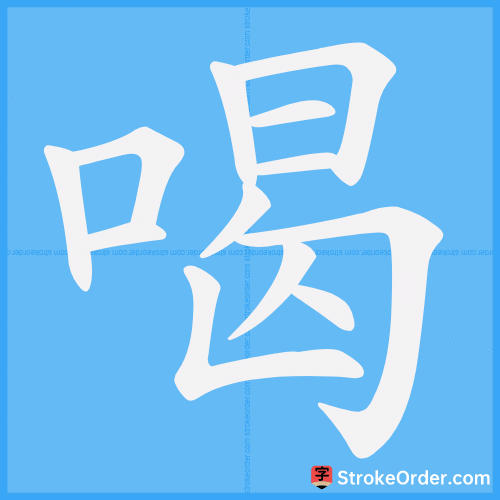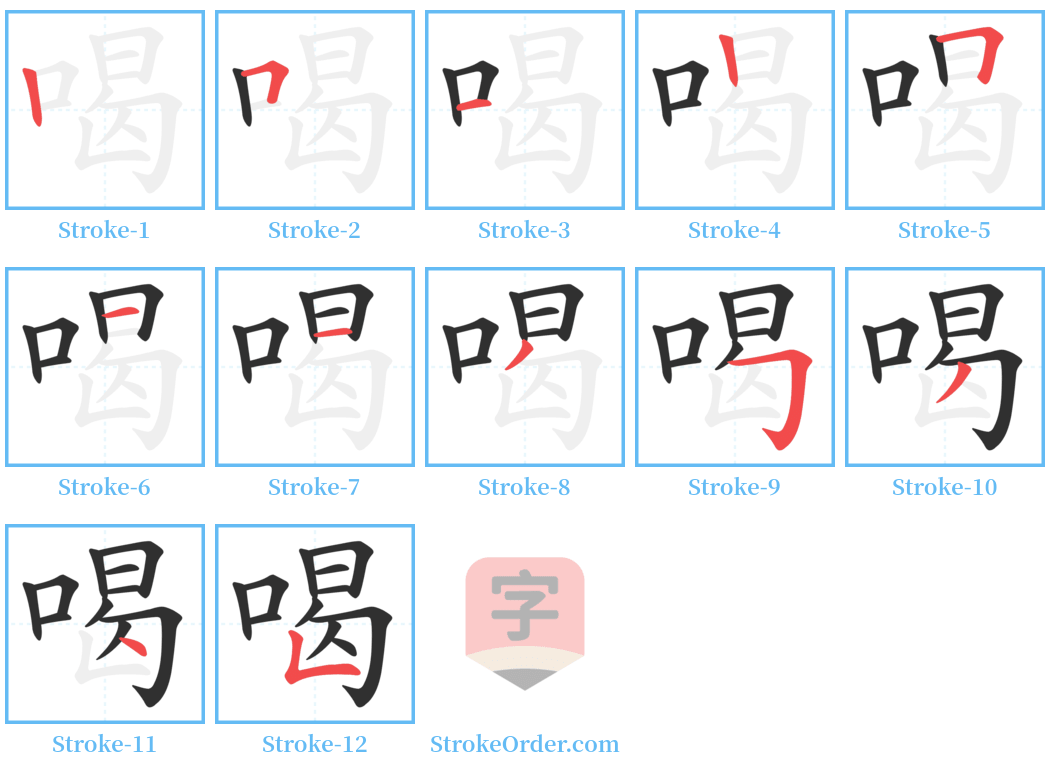喝 Stroke Order
Animated Stroke Order of 喝

Stroke Order Diagrams for 喝

Step-by-Step Handwriting Guide for 喝

Learn to Write Chinese Characters with Video Tutorials
Watch the video of writing the Chinese character "喝", learn the correct stroke order (笔顺) of the character "喝", and master the standard way of writing the character "喝".
Free Printable Handwriting Practice with Stroke Order: 喝
Printable Writing Practice Worksheet of "喝" in Portrait Orientation (Tian Zi Ge)

Printable Writing Practice Worksheet of "喝" in Landscape Orientation (Tian Zi Ge)

Information of 喝
Pinyin
hē、 hè
Radical
口
Strokes
12 strokes
Usage
★★★★★
Definition
my goodness / to drink, shout applause
喝 [hē]
Verb:
1. To swallow liquid drinks or liquid food.
Example: 喝水 (drink water), 喝酒 (drink alcohol), 喝茶 (drink tea), 喝粥 (drink porridge).
2. Specifically refers to drinking alcohol.
Example: 喝醉了 (got drunk).
Verb:
- (Onomatopoeic character, derived from mouth and echoing sound.) The original meaning: a soft sound, such as a whisper. Also refers to drinking, specifically alcohol. In northern regions, drinking is called 喝 (English: drink). Examples: 喝水 (drink water), 喝茶 (drink tea), 喝汤 (drink soup), 喝咖啡 (drink coffee).
Exclamation:
1. Used to express surprise.
Equivalent to 同“嗬” (English: oh).
2. See also hè.
喝 [hè]
Verb:
1. To shout loudly.
Example: 喝彩 (cheer), 喝问 (call out to inquire).
2. To threaten or intimidate.
3. To cry out the price of goods when selling.
4. To shout.
5. See also hē.
Verb:
1. To shout loudly (English: shout loudly).
2. To intimidate or threaten (English: threaten).
3. To announce prices during a sale (English: cry one's wares).
4. To call out (English: cry).
5. See also hē.
1. To have a hoarse voice or be choked up.
Example: "If a baby is born and cries out in a loud, strong voice, it indicates a long life; if the voice is hoarse and choked, it indicates a short life." This phrase emphasizes the importance of voice quality at birth.
Adjective: Having a hoarse or choked voice.
Historical references: Han Dynasty's Wang Chong mentioned in "Lunheng": "A baby born with a loud and clear cry shows longevity; a hoarse and choked cry indicates a short life." Also referenced in "Book of the Later Han."
to shout / to bawl / to yell (to urge on an animal) / to hawk (one's wares) / to denounce loudly / to shout slogans
Input Method for 喝
Pinyin
he1
Wubi
kjqn
Cangjie
rapv
Zhengma
jkry
Four Corner
66027
Unicode
U+559d
Same Pronunciation Characters